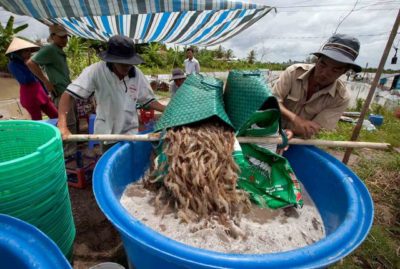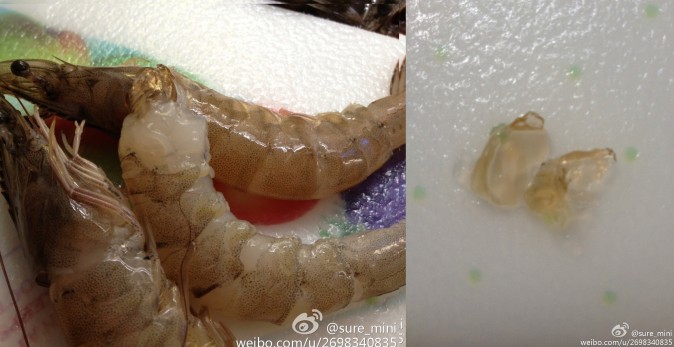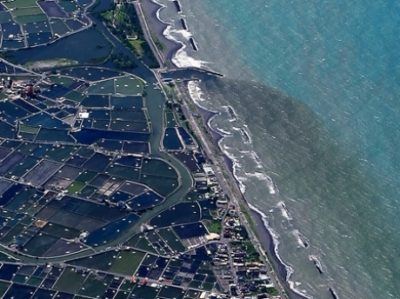
Chinese produce exports have made headlines in recent months for the use of fake ingredients, dangerous additives, and exposure to toxic soil and water. China’s government has been both reluctant and ineffective in dealing with the problem, forcing those who buy and consume Chinese-grown fruits and vegetables to gamble with their health. However, it turns out that similar problems plague another class of food exports – seafood. Shrimp farms throughout Asia have been caught using toxic additives to improve shrimp appearance and increase weight as well as raising shrimp in extremely unsanitary conditions. This is an issue that seafood lovers cannot afford to ignore as nearly 94% of all frozen shrimp in the US comes from Asian countries. Yet, not even 2% of those shrimp exports are inspected by US regulatory agencies.
Over half of all the shrimp grown globally are raised on aquaculture “farms” in China, Vietnam, Thailand, India, and Indonesia among a handful of other countries. These farms are incredibly unsanitary and use banned chemical cleaners and prohibited antibiotics to keep the shrimp from dying en masse due to the deplorable conditions in which they are raised. Some of these antibiotics such as nitrofurazone and chloramphenicol are carcinogenic and are banned due to severe side effects such as aplastic anemia and leukemia. An ABC News report found that many samples of Asian-grown shrimp contained high traces of these banned chemicals, some at 150 times the legal limit.

Mouse and rat hair, as well as pieces of insects, have also been found in shrimp and fish coming from these farms. On many farms, shrimp and fish are fed pig, chicken, and goose manure, which often contains salmonella and E.coli. Perhaps it’s not surprising, then, that nearly a quarter of all food-borne illness outbreaks in the US from 2005 to 2010 were caused by seafood – more than any other commodity. Contamination with feces also accounted for more than 25% of all contaminated seafood imports detained by the FDA in 2001, with more than half of them shrimp.
Shrimp packaging and processing plants are equally filthy. In 2012, a group of Bloomberg reporters visited several such facilities throughout Asia and found horrendous sanitary conditions at nearly all of them. In one Vietnamese facility, the processing plant’s floors were littered with garbage and flies while the shrimp were not being stored at appropriate temperatures. The shrimp were also packed with ice made from local tap water – water filled with dangerous microbes and bacteria.
Shrimp processors and wholesalers in Asia, who often sell directly the seafood export companies, have also adopted the curious practice of injecting shrimp with additives to enhance the physical appearance and color of the shrimp as well as to increase weight. A video report that went viral shows one supplier injecting shrimp with various substances using 30 different chemical pumps. Some of the chemicals used include carboxymethyl cellulose (CMC), gelatin, and glucose. A facility worker confessed during the report that she has no choice about injecting the shrimp with additives as “all local shrimp suppliers” do this, speaking to the widespread nature of the practice.

CMC is defined as a “water-soluble anionic linear polymer” and is used as a food additive. There are three different grades of CMC: food grade, technical grade, and industrial grade. The FDA recognized the purest form, food grade, as safe even though no new studies have tested the substance since the 1970s. However, much of the CMC used in shrimp injections is industrial grade as it is twice as cheap as food grade CMC. Industrial CMC contains significant amounts of sodium chloride and sodium glycolate, making it dangerous for consumers with heart problems, high blood pressure, and sodium sensitivity.
Even more dangerous than CMC is the gelatin used to make shriveled shrimp appear “plump” and “fresh.” Wu Wenhui, a professor at Shanghai Ocean University, said in an interview that much of the gel is industrial grade and is often used in the making of furniture and plastic products. According to Wenhui, this gel “contains many heavy metals such as lead and mercury, which harms the liver and blood, and is even carcinogenic.”

Yet, consumers are not the only ones who suffer from the unsanitary and dangerous practices of the Asian seafood aquaculture industry. Workers on shrimp and fish farms are often treated like slaves. A six-month-long investigation by the Guardian found that companies use torture, wage-theft, and beatings to keep workers compliant under unsafe conditions and to force them to work at reduced or no pay. The environment has also suffered as a result of industry practices. Many of these farms are placed along the coastline to avoid the installation of expensive water pumps. As the industry has expanded, a massive amount of native mangrove forests and wetlands have been destroyed to make room for more farms. Over the past 50 years, some countries have seen up to 80% of their mangrove forests destroyed as a result. These mangrove habitats are also home to commercial seafood species that are caught wild, such as snapper, wild tilapia, sea bass, oysters, and crabs. Food & Water Watch estimates that for each acre of mangrove destroyed, 675 pounds of commercial fish are lost, a crushing blow to local fisherman and native ecosystems.
Knowing all of this, the question then becomes – is there any shrimp that is safe to eat? In the US, it’s possible to find clean and responsibly raised shrimp, such as the Wood’s Fishery in Florida, but most of all domestically caught shrimp is tainted with oil. The BP “Deepwater Horizon” spill of 2010 all but wiped out the possibility of clean shrimp from the Gulf of Mexico, much of which is now a giant “dead zone” where no life can exist due to a lack of dissolved oxygen in the water. Not only that but the very chemical used to “clean up” the oil, known as Corexit, has only made matters worse. Corexit is toxic and becomes even more toxic in the presence of oil. It was chosen because it causes the oil to sink underwater, only making the ocean “look” clean. In our now highly polluted world, eating seafood is quickly becoming more of a health risk than a popular delicacy.
Companies in Vietnam inject substances to shrimps in order to increase sales. Vietnam is one of the top 5 exporters of shrimps, which are the most consumed sea animal in the world. Even though animal flesh is known to be unhealthy, it seems that these days it's more dangerous than ever…
Posted by Best Video You Will Ever See on Thursday, September 29, 2016
What are your thoughts? Please comment below and share this news!
This article (Your Seafood Is Probably Toxic: The Shocking Truth About Shrimp Farms In Asia) is free and open source. You have permission to republish this article under a Creative Commons license with attribution to the author and TrueActivist.com


